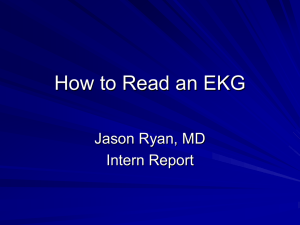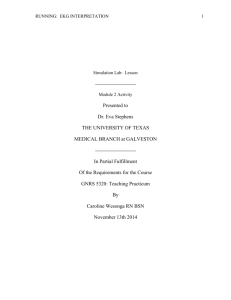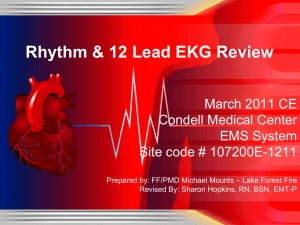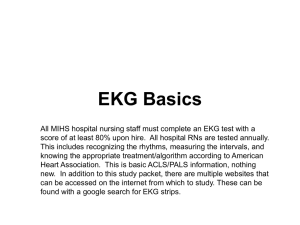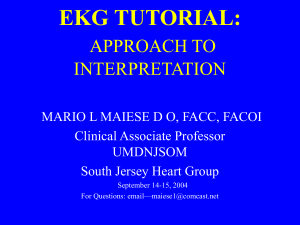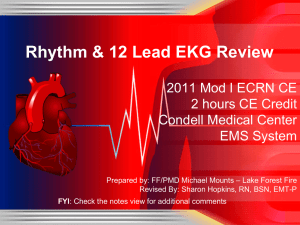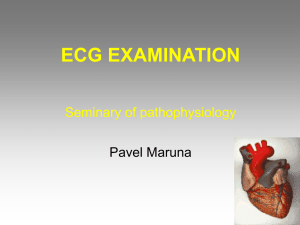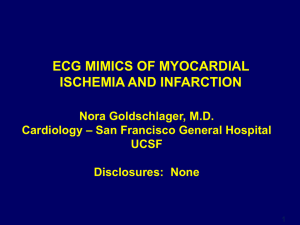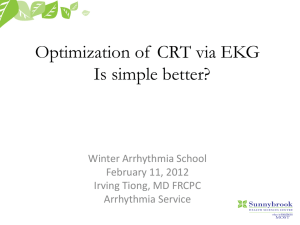Basic cardiology intro - WL Clarke PCT and Health Science Resources
advertisement
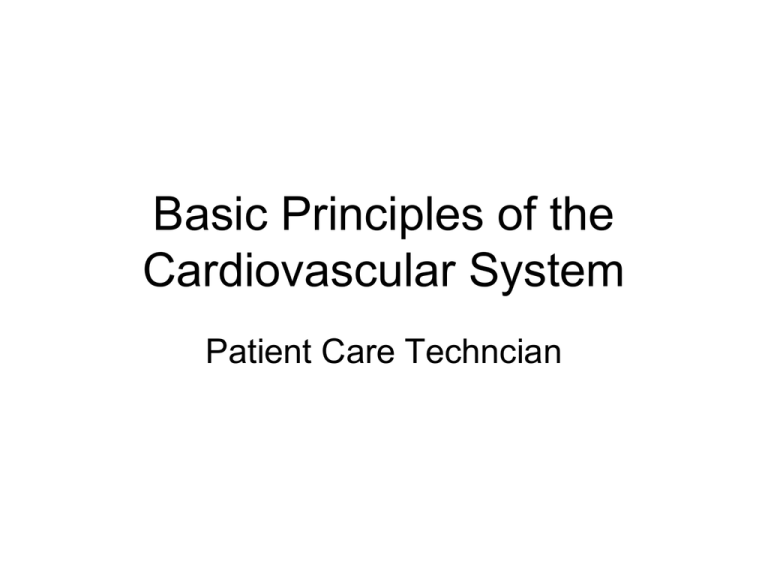
Basic Principles of the Cardiovascular System Patient Care Techncian Objectives – Describe the structures of the heart. – Explain the pumping mechanism of the heart and the path of blood flow through the heart. – Distinguish between pulmonary circulation and systemic circulation. – List the components of the conduction system and the sequence of impulse origination. – State four properties of cardiac cells. Anatomy of the Heart • • • • 4 chambered pump Weighs less than 1 pound Size of closed fist Located in mediastinum – between lungs, sternum, spine Chambers Valves Question • The right side of the heart pumps just as much blood as the left side – why are the walls of the right side thinner than those of the left? Where are these valves? • • • • Tricuspid valve Mitral valve Pulmonary semilunar valve Aortic valve Chordae tendoneae Heart Layers Heart Layers • Endocardium – layer of smooth cells that line heart • Myocardium – layer of muscle that cause contraction (myocardial infarction) • Epicardium – fatty layer that protects heart • Pericardial sac – holds heart in place, reduces friction of beat Circulation • Pulmonary • Systemic • Coronary Pulmonary Circulation Pulmonary Circulation Systemic Circulation Coronary Circulation Coronary Circulation Coronary Circulation • Anterior (A) and posterior (B) views of epicardial coronary circulation. LAD indicates left anterior descending coronary artery; AIV, anterior interventricular vein; CFX, circumflex coronary artery; RCA, right coronary artery; GCV, great cardiac vein; PDA, posterior descending artery; CS, coronary sinus; MCV, middle coronary vein; and SCV, small coronary vein. Question • Where and when do coronary arteries fill? Coronary Sinus Blood Vessels • Define the following: – – – – – – – – – Artery Arteriole Vein Venule Capillary Aorta Vena Cava Pulmonary artery Pulmonary vein Question • What vessels, structures and/or organs are included in each type of circulation? Question • Show the path of a drop of blood from the right atrium back to the right atrium. – Be sure to include major vessels, organs, and valves. Cardiac cycle • Series of events that constitute complete heartbeat – Atrial systole - Contraction of atria to pump blood to ventricles – Ventricle systole – contraction of ventricles to pump blood to body – Atrial diastole – the atria begin refilling during ventricular systole – Ventricular diastole – blood from the atria begins refilling the ventricles during atrial systole. Conduction Pathways • Network of conducting tissue • Specialized cells – do not contract • Initiates each heartbeat and controls rhythm Sinoatrial Node • Located in right atrium • Main cardiac pacemaker • Normally generates impulses at rate of 60 to 100 beats per minute Atrioventricular Node • Receives impulse via internodal pathways • Located in floor of atrium near septum • Delay the impulse to allow ventricular filling • Intrinsic rate 40 to 60 • Two basic functions – Protect ventricles from fast heart rate that may originate in atrium – Serves as pacemakers if SA node fails AV Bundle or Bundle of His • Conducts impulse from AV Node • Divides into right and left bundle branches at intraventicular septum – Right bundle branch supplies right ventricle – Left bundle branch splits • Anterior supplies upper portion of left ventricle • Posterior supplies lower portion of left ventricle Purkinje Fibers • Enlarged fibers • Spread along septum toward apex and over lateral walls of ventricles • Work with Bundle of His and bundle branches to contract ventricles • Intrinsic rate 20 to 40 • May act as backup pacemaker Cardiac Electrical System Cool Website! • http://science.howstuffworks.com/environ mental/life/human-biology/heart4.htm Special Properties of Cardiac Cells • Automaticity – ability to generate own impulse and maintain rhythmic activity • Excitability – ability of all heart cells to respond to impulse • Conductivity – cardiac cell able to relay impulse to neighboring cells and create wave of excitation • Contractility – ability to respond to electrical impulse with pumping action Two Types of Cardiac Cells • Capable of contraction • Capable of conduction Contraction of the Heart • Cell membrane must be electrically activated • Depolarization - Positive ions move into cell and negative ions move out of cell • Repolarization – negative ions return to inside of cell and positive ions move out of cell • This movement of ions is recorded by EKG Cardiac Terminology • Systole Electrical Cycle Depolarization Mechanical Cycle Diastole Repolarization Activation Recovery Excitation Recovery Contraction Relaxation Emptying Filling Shortening Lengthening EKG Representation of Heartbeat The Normal Electrocardiogram Objectives • Explain how electrical current in the heart is generated • Differentiate between EKG waves, segments, intervals, and complexes • Describe how the movement of electricity through the heart produces predictable wave patterns • Describe the method of detection and recording of these wave patterns by the EKG machine Detection and Recording • Transmembrane potential – electrical difference between the inside and outside of the cell • Action potential – changes that occur during the process of depolarization and repolarization within a cell as activated by electrical impulse • Refractory period – time during which the cell is unable to respond to a stimulus • Vector – path of impulse displaying the direction and magnitude of the electrical current Normal Heart • Vector proceeds in same sequence • Vector is predictable EKG machine • Writing arm • Recording device (galvanometer) – Stylus needle responds by heat or pressure • Lead wires – Attaches electrodes to machine • Electrodes – Provides direct contact with skin EKG • Tracing of electrical voltage produced by continual depolarization and repolarization of heart • Shows direction and magnitude of electrical current produced by the heart Waves Deflections from the baseline Designated as: P, QRS, T Waves • P wave – depolarization of atria • Q wave – (may be absent) activation in intraventicular septum, first negative deflection of QRS • R wave – impulse progression through right and left ventricles, first upward deflection of QRS • S wave – completion of left ventricular activation • T wave – repolarization of ventricles Waves Segments • Straight lines or spaces between waves • ST segment – Measured from end of S wave to beginning of T wave – 0.35 to 0.45 seconds – Isoelectric (flat) Segments Intervals • Consists of wave and a connecting straight line • P-R Interval - measured from onset of P wave to beginning of QRS – Normal 0.12 to 0.20 seconds • QT Interval - measured from start of Q to end of T wave Intervals Complexes • Groups of related recorded waves • QRS complex – Represents depolarization or contraction of the ventricles – Normal length 0.04 to 0.10 Complexes Explanation of EKG paper Measuring Time Normal cycle 0.8 seconds Heart Rate Calculation #1 • Count the number of large squares between R waves and divide into 300 Heart Rate Calculation #2 • Count number of large blocks between R waves Heart Rate Calculation #3 • Count number of small squares between r waves and divide that number into 1500 • Most accurate method but can only be used for regular rhythms. Heart Rate Calculation #4 • • • • Get 6 second strip Count number of complete complexes Multiply by 10 (6 x 10 = 60 seconds or 1 minute) Special Note: Only method that can be used for irregular rhythm Normal Rhythm Identification - All P waves appear like all other P waves QRS complexes resemble each other P-R intervals are constant P-P intervals are constant R-R intervals are constant P before every QRS Rate is between 60 to 100 beats per minute Normal Sinus Rhythm • • • • • Regular P before every QRS, every complex looks the same P-R int. = 0.20 QRS = 0.10 Rate = approx. 75 Five Step Method • Step 1 evaluates the speed of the rhythm to determine if it is normal, too slow or too fast. A speed between 60-100 maintains the best hemodynamic stability. Rates less than 60 or greater than 100, can lead to hemodynamic instability and become symptomatic. • Step 2 asks if the rhythm is regular. Rhythms originating from the normal pacemakers in the heart will be regular. Irregular rhythms indicate extra beats or abnormal rhythms. • Step 3 assesses the shape of the complex. A narrow complex is normal. A wide complex indicates conduction abnormalities. • Step 4 asks if a P-wave precedes the QRS complex. This represents normal conduction from the atria to the ventricles. If the P-wave is absent, the impulse is being generated from elsewhere in the heart. • Step 5 assesses whether all the complexes look the same. Normal conduction follows the same pathway with each beat. Different looking complexes indicate the some impulses are following alternative or aberrant pathways. Abnormal rhythms – Sinus Bradycardia • Less than 60 beats per minutes • May be normal in athletes • Other aspects of EKG normal Abnormal Rhythms - Tachycardia • Over 100 beats per minute • May be caused by exercise or fever • Other aspects of EKG are normal Neat Websites • http://highered.mcgrawhill.com/sites/0073520713/student_view0/ chapter29/ecg_rhythm_exercises1/basic_ ecg_anatomy/rhythm_strip_quiz_1.html • http://www.mauvila.com/ECG/ecg.htm • http://www.ems1.com/columnists/EKG/arti cles/311340-Case-4-The-Pseudo-Normal/ Lead Systems Objectives • Describe the purpose of an EKG lead • Differentiate between unipolar and bipolar leads • Describe the orientation of all 12 leads • Explain chest and limb lead placement Leads • Each lead views the heart at a unique angle • Each lead has a positive and a negative pole – measures the electrical difference between the poles Limb Leads • Placed on arms and legs • Reflect impulses moving in vertical or frontal plane • Six leads: I, II, III, AVR, AVL, AVF Remember • Right and left refers to the patient’s right and left Limb Lead Placement • • • • RA right arm between elbow and shoulder LA left arm between elbow and shoulder RL right leg a few inches above ankle LL left leg a few inches above ankle – Alternate placement for leg leads upper legs as close to torso as possible Chest Leads • Demonstrate forces moving anteriorly and posterior in a tranverse plane Precordial Lead Placement • • • • V1 – right sternal border at 4th intercostal space V2 – left sternal border at 4th intercostal space V3 – Midway between 2nd and 4th V leads V4 – 5th intercostal space straight down from midclavicular notch • V5 – at anterior axillary line at same horizontal level as V4 • V6 – at midaxillary line on the same horizontal level as V4 and V5 Overview by Lead Identifying Rhythms Objectives • Identify normal sinus rhythm. • Differentiate between various sinus rhythms • Identify and distinguish each atrial dysrhythmia • Compare and contrast atrial and ventricular dysrhythmias Clinical Significance of EKG’s • PCT must recognize abnormal patterns and alert MD Sinus Rhythms • Rhythms beginning in the SA node • Characteristics – 1:1 relationship between P and QRS – P, QRS, T are in order and consistent in configuration – P-R interval is within 0.12 to 0.20 seconds – QRS interval is within 0.04 to 0.10 – Heart rate is 60 to 100 – P-R, P-P, R-R intervals are regular Terminology Question • What’s the difference? – Arrhythmia – Dysrhythmia Dysrhythmias Occur When • Disturbance in automaticity – rate to slow or too fast • Disturbance in conductivity – site of impulse formation is not in SA node • Combination of altered automaticity and conductivity – impulse conduction is abnormal Sinus Tachycardia • Impulse formation faster than normal • Rate is 100-160 beats per minute • Faster than normal but not fast enough to decrease cardiac output • Causes: exercise, fever, anxiety, hypovolemia (decreased fluid volume) • Same characteristics as Normal Sinus Rhythm except rate Sinus Bradycardia • Rate is 30 to 60 beats per minute • Slow rate can decrease cardiac output • Can be caused by vomiting, tracheal suctioning, valsalva maneuver, drug side effects Sinus Arrhythmia • Impulses originate in SA node but speed up with inspiration and slow with expiration • P-P and R-R intervals vary Sinus Arrest or Pause • • • • Potentially lethal SA Node fails Beats dropped but bets that do occur appear normal Sudden decrease in cardiac output can cause dizziness, syncope or angina • Patient may need permanent pacemaker Atrial Arrhythmias • Abnormal electrical activity occurring in the atria before the sinus impulse can occur Premature Atrial Contractions • • • • • Early firing from ectopic focus in the atria Appear earlier than normal in cycle Have abnormal P wave and abnormal P-R QRS usually normal May be caused by alcohol, caffeine, nicotine, low potassium, heart or lung disease Arial Tachycardia • Heart rate is 150 to 200 • P wave may be abnormal or hidden in preceding T wave • Decreased cardiac output due to rate and increased oxygen demand Atrial Fibrillation • • • • • • Possibly lethal No P waves, P-R can’t be measured QRS normal but R-R irregular Causes: underlying heart disease May be chronic Danger of clots (pulmonary or cerebral) – patient may be on blood thinner to prevent Atrial Flutter • Ectopic atrial focus takes over - generates impulse faster than SA node • Multiple P waves in sawtooth pattern • QRS normal • Atrial rate 250 to 350, regular • Ventricular rate varies but is regular • AV node blocks some impulses Junctional Rhythms • Impulses originating from ectopic focus in AV node region – fire earlier than SA node • P wave is negative and may occur before, during, or after the QRS • P-R may be shortened or not measurable • QRS usually normal • May predispose heart to more serious dysrhythmias Junctional Rhythm Ventricular Rhythms • Impulse originates from an ectopic in the bundle branches, Purkinje fibers, or ventricular muscle before SA node • Beat caused by this impulse does not produce adequate cardiac output • P wave is absent – no P-R interval • ORS is premature, wide, bizarre • May be caused by hypoxemia, stress, electrolyte imbalance, caffeine, nicotine, alcohol, medication toxicity, myocardial infarction • MAY BE NORMAL FOR PATIENT Premature Ventricular Contractions • Wide, bizarre complex which occurs early • Example: Unifocal Premature Ventricular Contractions • Wide, bizarre complex which occurs early • Example: Multifocal Premature Ventricular Contractions • Wide, bizarre complex which occurs early • Example: Couplet Premature Ventricular Contractions • Wide, bizarre complex which occurs early • Example: Salvo or triplet Premature Ventricular Contractions • Wide, bizarre complex which occurs early • Example: Bigemeny Premature Ventricular Contractions • Wide, bizarre complex which occurs early • Example: Trigeminy R-on-T • Occurs when R of PVC falls on T of preceeding beat • Heart vulnerable to electrical stimulation • Usually does not produce a sustained ventricular dysrhythmia Ventricular Tachycardia • • • • • • • Three ectopic ventricular beats Rate 100 to 250 per minute, regular Possible lethal arrhythmia No P waves, no P-R QRS consecutive, wide, bizarre Decreased or NO cardiac output Will deteriorate into V Fib if not treated Ventricular Fibrillation • • • • CHECK LEADS!!!!! Ventricular rhythm is chaotic Results from multiple ectopic foci in ventricles Ventricles quiver instead of contracting – NO CARDIAC OUTPUT • Will deteriorate into asystole Agonal • Wide bizarre complexes from multiple ventricular pacemakers Asystole • CHECK LEADS • No electrical activity S-T elevation • • • • • Rhythm - Regular Rate - varies QRS Duration - Normal P Wave - Normal S-T Element does not go isoelectric which indicates infarction A-V Block – First Degree • • • • • • • • Caused by a conduction delay through the AV node but all electrical signals reach the ventricles Rarely causes any problems by itself – may be seen in athletes Rhythm - Regular Rate - Normal QRS Duration - Normal P Wave - Ratio 1:1 P Wave rate - Normal P-R Interval - Prolonged (>5 small squares) A-V Block – Second Degree Type I • • • • • • • • • Also called Wenckebach Conduction block of some, but not all atrial beats getting through to the ventricles Progressive lengthening of the PR interval and then failure of conduction of an atrial beat, this is seen by a dropped QRS complex. Rhythm - Regularly irregular Rate - Normal or Slow QRS Duration - Normal P Wave - Ratio 1:1 for 2,3 or 4 cycles then 1:0. P Wave rate - Normal but faster than QRS rate P-R Interval - Progressive lengthening of P-R interval until a QRS complex is dropped A-V Block – Second Degree Type II • • • • • • • • Electrical excitation sometimes fails to pass through the A-V node or bundle of His Constant P-R interval but not regularly followed by ventricular contraction Rhythm - Regular Rate - Normal or Slow QRS Duration - Prolonged P Wave - Ratio 2:1, 3:1 P Wave rate - Normal but faster than QRS rate P-R Interval - Normal or prolonged but constant A-V Block – Third Degree • • • • • • • • • Atrial contractions are 'normal' but no electrical conduction is conveyed to the ventricles. Ventricles then generate their own signal through an 'escape mechanism' from a focus somewhere within the ventricle. Ventricular escape beats are usually 'slow' Rhythm – Regular P and Regular QRS but they are not related! Rate - Slow QRS Duration - Prolonged P Wave - Unrelated P Wave rate - Normal but faster than QRS rate P-R Interval - Variation Paced Rhythms Acquiring the EKG Objectives • Demonstrate correct use of EKG equipment • Perform simple maintenance and troubleshooting • Perform accurate, diagnostic EKGs • Explain effects of patient position • Understand concept of electrical conduction through the skin • Demonstrate proper skin prep and lead placement • Recognize artifact and practice artifact prevention Equipment • • • • • Modern machines are multichannel Can transmit EKG via telephone lines Machine may store EKGs Has 10 lead wires Always follow manufacturers directions for use, cleaning, storage Other considerations • Drape lead wires over machine – do not fold or tie • Inspect lead wires for breaks/frays • Do not put food or liquids on cart • Do not put anything on screen • Be sure machine stays plugged in when not in use • Store electrodes properly – gel can dry out Question • What are beginning actions for any procedure? Patient Preparation • Check physician order or be familiar with protocol • Check patient ID with two identifiers • Wash hands • Explain procedure • Provide privacy Patient Position • Place patient in supine position • Patient may be at 45 degree angle if short of breath • Have patient uncross legs Skin Preparation • Electrode contact with skin important • May have to wash dirty/scaly skin – – Epidermis is poor conductor • • • • Chest hair should be shaved Use alcohol to remove skin oils Wipe excess perspiration with 4 x 4 Apply pressure to edges of electrode – not center Recognizing Artifact • Extraneous electrical activity • Can be reduced by having patient touch only the mattress – not bed rails • Keep patient quiet and calm • Keep patient warm • Position electrodes high on extremities if patient has tremor • Be sure all leads are attached Wandering Baseline 60 cycle interference Patient Movement BE SURE THAT YOU ARE TREATING THE RHYTHM NOT THE ARTIFACT! Special Situations • Dextrocardia – reverse precordial leads • Large breasts – do NOT place electrodes on top of breast • Bilateral breast implants you should apply V4, V5, and V6 close to the midaxillary line. • Note patient abnormalities on EKG • Do not place electrodes on open wounds, burns, or clear dressings • Do not allow electrodes to touch one another
